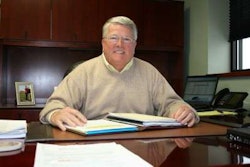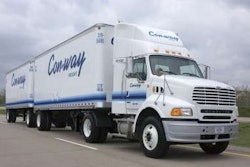Future engines someday could supplant 2010 technology -by John Baxter
The 2010 engines with selective catalytic reduction (SCR) featuring reduced engine stress and fuel consumption look like a slam-dunk. But in spite of the coming wave of vehicles with SCR, chances are that the technology eventually will be supplanted.
One approach is to alter the aftertreatment system so it no longer will be necessary to supply diesel exhaust fluid (DEF). Jeremy Holt, president of Nxtgen Emission Controls, says his company has such a system that’s out of the design stage and now in the certification process. It combines what Holt calls “a syngas generator” with a diesel particulate filter (DPF) and a lean NOx trap (LNT).
The syngas generator has a small electric blower and glow plug and burns diesel fuel at a rich mixture ratio, the total flow being only about 2 percent of engine flow. This produces carbon monoxide (CO) and hydrogen in a partial reaction. When these products are subjected to normal diesel exhaust temperatures, they burn using the oxygen that’s always in diesel exhaust, especially under light load, and heat the exhaust. The result, says Holt, is a DPF that can keep itself clean even when the engine is loaded lightly.
The LNT catches NOx and holds it, but it must be regenerated before it fills up. The syngas is routed through the LNT for about 30 seconds every couple of miles without extra air with oxygen being added. The CO and hydrogen, being oxygen-deprived, become CO2 and water vapor, converting the Nox to nitrogen. A dual trap system allows one trap to be regenerated while the other continues to catch the Nox emitted by the engine.
Eaton has a competitive system that is similar but adds a thermal mass after the reformer – making the hydrogen and CO “reformate” – as well as an SCR catalyst following the DPF. The SCR catalyst generates and stores ammonia during those periods when the LNT is being regenerated, then uses it continuously to reduce Nox at the back end of the process. When the LNT is full, the reformer sends in a large dose of reformate, which is kept from getting too hot by the thermal mass and then arrives in the LNT to convert the NOx to nitrogen. It also removes sulfur, which otherwise would poison the trap gradually.
The system injects the fuel used for regeneration with the patented Advanced Reagent Injector System from Clean Diesel Technologies. “Eaton’s versatile solution makes use of diesel or fuels from renewable resources to meet emissions standards without the logistical and cost-related issues associated with onboard urea storage and wide-scale urea distribution,” says Vishal Singh, manager for Eaton’s aftertreatment business unit.
But this is only the beginning: According to a groundbreaking SAE paper – entitled “The Potential of HCCI Combustion for High Efficiency and Low Emissions” – the internal combustion engine of the future may work like model airplane engines. According to the paper, “Homogeneous Charge Compression Ignition (HCCI) engines can have efficiencies as high as compression-ignition direct-injection (CIDI) engines (an advanced version of the commonly known diesel engine) while producing ultra-low emissions of oxides of nitrogen (Nox) and particulate matter (PM).” Translation: No DPF or SCR.
“HCCI is potentially applicable to both automobile and heavy-truck engines,” the paper reads. How does HCCI work? The fuel and air will be premixed like in a car, but ignition will occur via compression as in a diesel, just like in a model airplane’s engine.
An early version of this is PCCI, or Premixed-Charge Compression Ignition. All that’s needed is variable intake valve timing, and reprogramming of the ECM to produce a short injection period that occurs much earlier than in a diesel. While PCCI only will work at cruise, it could produce amazing results.
Researchers at the University of Wisconsin Engine Research Center conducted a study to explore what would happen inside a truck diesel if a different sequence of events occurred so the fuel would have more time to mix. They found a set of operating conditions – including heavy exhaust gas recirculation (EGR) and closing the intake valve much later than normal – that yielded terrific results. The fuel stops going in almost 19 degrees before the piston gets to the top. Ignition doesn’t occur until a few degrees after all the fuel is in the cylinder, a decisive departure from the diesel concept where injection and burning overlap. The result was a decrease in soot of 48 percent, a reduction in NOx + hydrocarbons (unburnt fuel) of a whopping 82 percent, and a reduction in fuel consumption of 7.4 percent.
But, making PCCI – and eventually HCCI – work will be a major challenge. One key to doing this, according to University of Wisconsin professor Dr. Rolf Reitz, may be using gasoline and diesel fuel together in existing truck engines. “You would be able to eliminate SCR that uses DEF in favor of gasoline, a substance that’s widely available,” Reitz says. “You can run a diesel on gasoline and get greatly reduced exhaust emissions. Plus, you don’t need the high injection pressures.”
Gasoline prevents the preignition that occurs with diesel fuel when injected early in a diesel, Reitz says. Such an engine might use diesel fuel under light loads; under heavier loads, gasoline would take over, possibly even using spark ignition and a three-way catalyst.












